Xiaoyue Jiang
Hardening RGB-D Object Recognition Systems against Adversarial Patch Attacks
Sep 13, 2023



Abstract:RGB-D object recognition systems improve their predictive performances by fusing color and depth information, outperforming neural network architectures that rely solely on colors. While RGB-D systems are expected to be more robust to adversarial examples than RGB-only systems, they have also been proven to be highly vulnerable. Their robustness is similar even when the adversarial examples are generated by altering only the original images' colors. Different works highlighted the vulnerability of RGB-D systems; however, there is a lacking of technical explanations for this weakness. Hence, in our work, we bridge this gap by investigating the learned deep representation of RGB-D systems, discovering that color features make the function learned by the network more complex and, thus, more sensitive to small perturbations. To mitigate this problem, we propose a defense based on a detection mechanism that makes RGB-D systems more robust against adversarial examples. We empirically show that this defense improves the performances of RGB-D systems against adversarial examples even when they are computed ad-hoc to circumvent this detection mechanism, and that is also more effective than adversarial training.
Why Adversarial Reprogramming Works, When It Fails, and How to Tell the Difference
Aug 31, 2021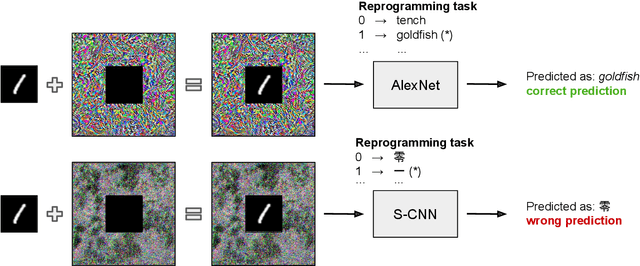
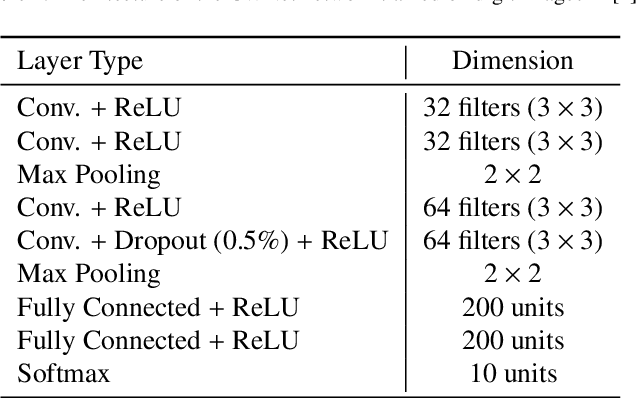

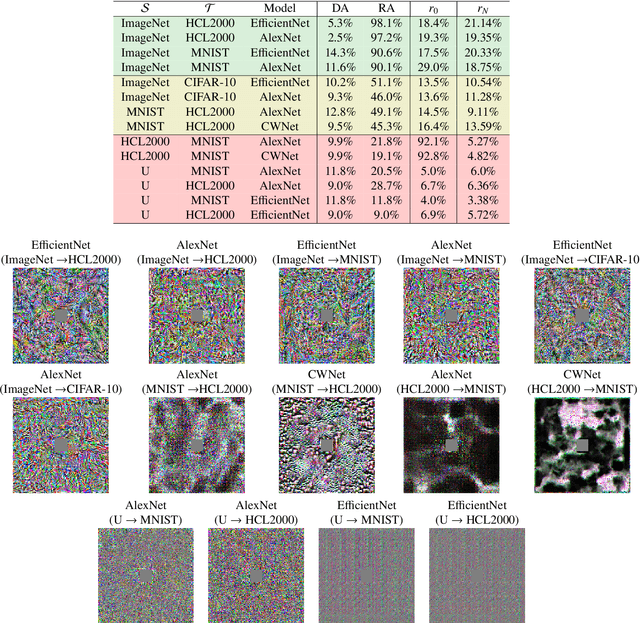
Abstract:Adversarial reprogramming allows repurposing a machine-learning model to perform a different task. For example, a model trained to recognize animals can be reprogrammed to recognize digits by embedding an adversarial program in the digit images provided as input. Recent work has shown that adversarial reprogramming may not only be used to abuse machine-learning models provided as a service, but also beneficially, to improve transfer learning when training data is scarce. However, the factors affecting its success are still largely unexplained. In this work, we develop a first-order linear model of adversarial reprogramming to show that its success inherently depends on the size of the average input gradient, which grows when input gradients are more aligned, and when inputs have higher dimensionality. The results of our experimental analysis, involving fourteen distinct reprogramming tasks, show that the above factors are correlated with the success and the failure of adversarial reprogramming.
3D Face Mask Presentation Attack Detection Based on Intrinsic Image Analysis
Mar 27, 2019
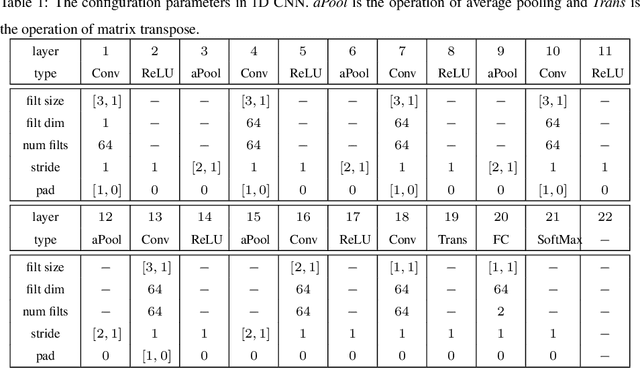
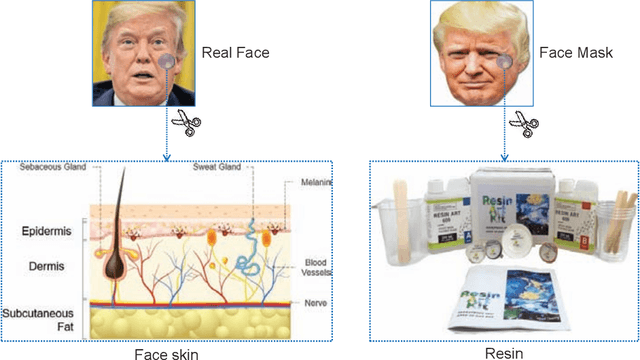
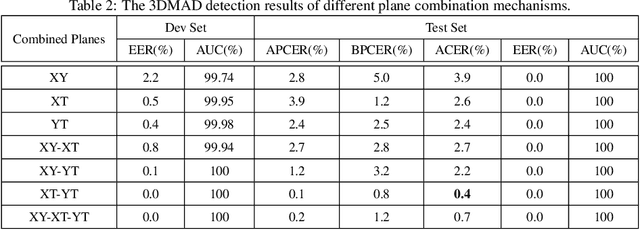
Abstract:Face presentation attacks have become a major threat to face recognition systems and many countermeasures have been proposed in the past decade. However, most of them are devoted to 2D face presentation attacks, rather than 3D face masks. Unlike the real face, the 3D face mask is usually made of resin materials and has a smooth surface, resulting in reflectance differences. So, we propose a novel detection method for 3D face mask presentation attack by modeling reflectance differences based on intrinsic image analysis. In the proposed method, the face image is first processed with intrinsic image decomposition to compute its reflectance image. Then, the intensity distribution histograms are extracted from three orthogonal planes to represent the intensity differences of reflectance images between the real face and 3D face mask. After that, the 1D convolutional network is further used to capture the information for describing different materials or surfaces react differently to changes in illumination. Extensive experiments on the 3DMAD database demonstrate the effectiveness of our proposed method in distinguishing a face mask from the real one and show that the detection performance outperforms other state-of-the-art methods.
Face Presentation Attack Detection in Learned Color-liked Space
Oct 31, 2018


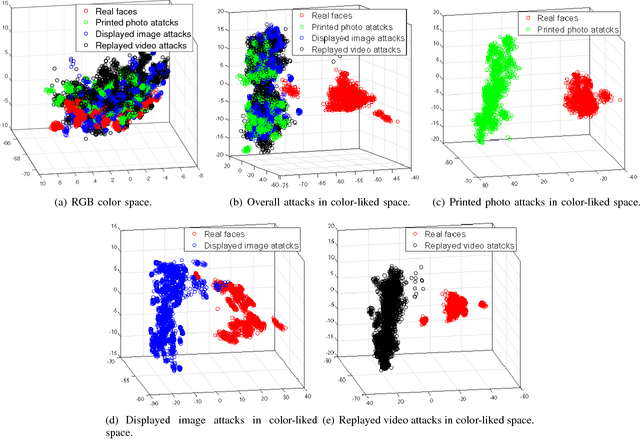
Abstract:Face presentation attack detection (PAD) has become a thorny problem for biometric systems and numerous countermeasures have been proposed to address it. However, majority of them directly extract feature descriptors and distinguish fake faces from the real ones in existing color spaces (e.g. RGB, HSV and YCbCr). Unfortunately, it is unknown for us which color space is the best or how to combine different spaces together. To make matters worse, the real and fake faces are overlapped in existing color spaces. So, in this paper, a learned distinguishable color-liked space is generated to deal with the problem of face PAD. More specifically, we present an end-to-end deep learning network that can map existing color spaces to a new learned color-liked space. Inspired by the generator of generative adversarial network (GAN), the proposed network consists of a space generator and a feature extractor. When training the color-liked space, a new triplet combination mechanism of points-to-center is explored to maximize interclass distance and minimize intraclass distance, and also keep a safe margin between the real and presented fake faces. Extensive experiments on two standard face PAD databases, i.e., Relay-Attack and OULU-NPU, indicate that our proposed color-liked space analysis based countermeasure significantly outperforms the state-of-the-art methods and show excellent generalization capability.
Local feature hierarchy for face recognition across pose and illumination
Jul 12, 2016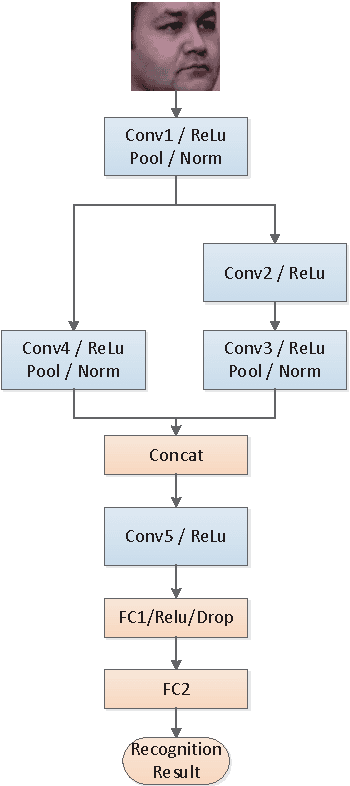


Abstract:Even though face recognition in frontal view and normal lighting condition works very well, the performance degenerates sharply in extreme conditions. Recently there are many work dealing with pose and illumination problems, respectively. However both the lighting and pose variation will always be encountered at the same time. Accordingly we propose an end-to-end face recognition method to deal with pose and illumination simultaneously based on convolutional networks where the discriminative nonlinear features that are invariant to pose and illumination are extracted. Normally the global structure for images taken in different views is quite diverse. Therefore we propose to use the 1*1 convolutional kernel to extract the local features. Furthermore the parallel multi-stream multi-layer 1*1 convolution network is developed to extract multi-hierarchy features. In the experiments we obtained the average face recognition rate of 96.9% on multiPIE dataset,which improves the state-of-the-art of face recognition across poses and illumination by 7.5%. Especially for profile-wise positions, the average recognition rate of our proposed network is 97.8%, which increases the state-of-the-art recognition rate by 19%.
 Add to Chrome
Add to Chrome Add to Firefox
Add to Firefox Add to Edge
Add to Edge